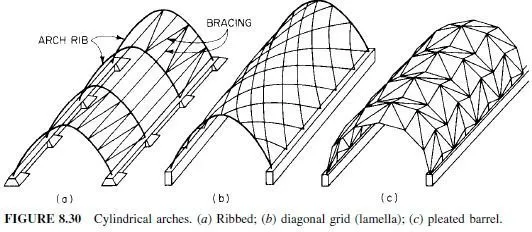Overdetailing of weld sizes and joint configurations can cause unnecessary fabrication and in-service problems and higher costs. Some designers believe more weld metal is better and complete-penetration groove welds are better than fillet welds. But oversizing welds or specifying joint figurations that are not practical can cause weld defects that are otherwise avoidable.
Whenever possible, designers should allow fabricators to select the type of joint to be used and the size of weld (Fig. 11.13). Include maximum and minimum sizes for fillet welds as follows:
Limitations on Fillet-Weld Size. The maximum size of a fillet weld is the same as the material thickness, up to 1â„4 in. For material 1â„4 in thick or more, size is limited to 1â„16 in less than the material thickness, unless the drawings indicate that the weld should be built up to get full throat thickness.
Minimum size of fillet weld is based on the base-metal thickness of the thinner part joined, and single-pass welds must be used. For material 3â„4 in thick or less, weld size should be at least 1â„4 in. For thicker material, weld size may not be less than 5â„16 in. Only if the strength requirement exceeds that provided by the minimum size of fillet weld is it necessary to indicate the size of a fillet weld on the drawings. The Bridge Welding Code, ANSI/ AASHTO/AWS D1.5, provides adequate assurance of proper weld strength and quality.
Letting fabricators select joint details for efficient utilization of their plant setup ensures the most costeffective fabrication.
The AASHTO specifications also require that the minimum length of a fillet weld be 4 times its size but at least 11â„2 in. If a fillet weld is subjected to repeated stress or to a tensile force not parallel to its axis, it should not end at a corner of a part or a member. Instead, it should be turned continuously around the corner for a distance equal to twice the weld size (if the return can be made in the same plane). End returns should not be provided around transverse stiffeners. Seal welds should be continuous.
Welding of Box Girders. Poor detailing of a box girder or other type of enclosed member has been another source of fabrication problems and has contributed to adverse in-service performance when designs have not provided properly for fabrication. For example, designers often specify a complete-penetration groove weld for a corner, and the backing bar neededto ensure integrity of the weld is not always installed properly. Backing bars are sometimes left discontinuous, and this soon causes a fatigue crack to initiate. Also, when internal stiffeners are required for a box girder, which is frequently the case for large sections, assembly problems are encountered where welds or backing bars are interrupted at the stiffeners. Figure 11.14 shows a detail with backing bar that is not recommended for a box girder and a preferred arrangement that eliminates both the need for a backing bar and for welding to be done inside the box for attachment of the web to the top plate.

The assembly procedure requires first welding of the two webs to the bottom flange. For the purpose, continuous fillet welds are placed on one or both sides. Then, the stiffeners are welded to the webs (also to the compression flange if the member will be subjected to bending). Finally, the top flange is connected to the webs with fillet welds. The advantage of this procedure lies in the fact that it is usually practicable to get a fillet weld of better quality, easier to inspect with a nondestructive test, and less expensive than a completepenetration weld.

Welding of HPS Steels. With the introduction of HPS to the designers inventory of steels, additional weld parameters must be considered. At the present time, HPS is a quenchedand- tempered (Q&T) steel. The LRFD Specification states that the engineer may specify electrode classifications with strengths less than the base metal when detailing fillet welds for Q&T steels. The Bridge Welding Code, AWS D1.5, also allows use of undermatched fillet welds for all steels where the stress is in tension or compression parallel to the weld axis, and shear on the effective area meets AASHTO design requirements. Although undermatched welds are applicable to any design, it is of particular importance for steels with strengths of 70 ksi and higher.
Rules for Fillet Welds. The following rules are recommended for detailing of fillet welds for all girders, particularly those of HPS:
1. Use only minimum size fillet welds, except where greater strength is required.
2. Use undermatched fillet welds (consumables for grade 50 steels) for grade 70 steels and higher.
3. Use non-weathering consumables for all single pass fillet welds (AWS D1.5, Art. 4.1.5) even on unpainted structures.
4. For fillet welds joining steels of two different yield points, use consumables applicable to the lower strength base metal.



